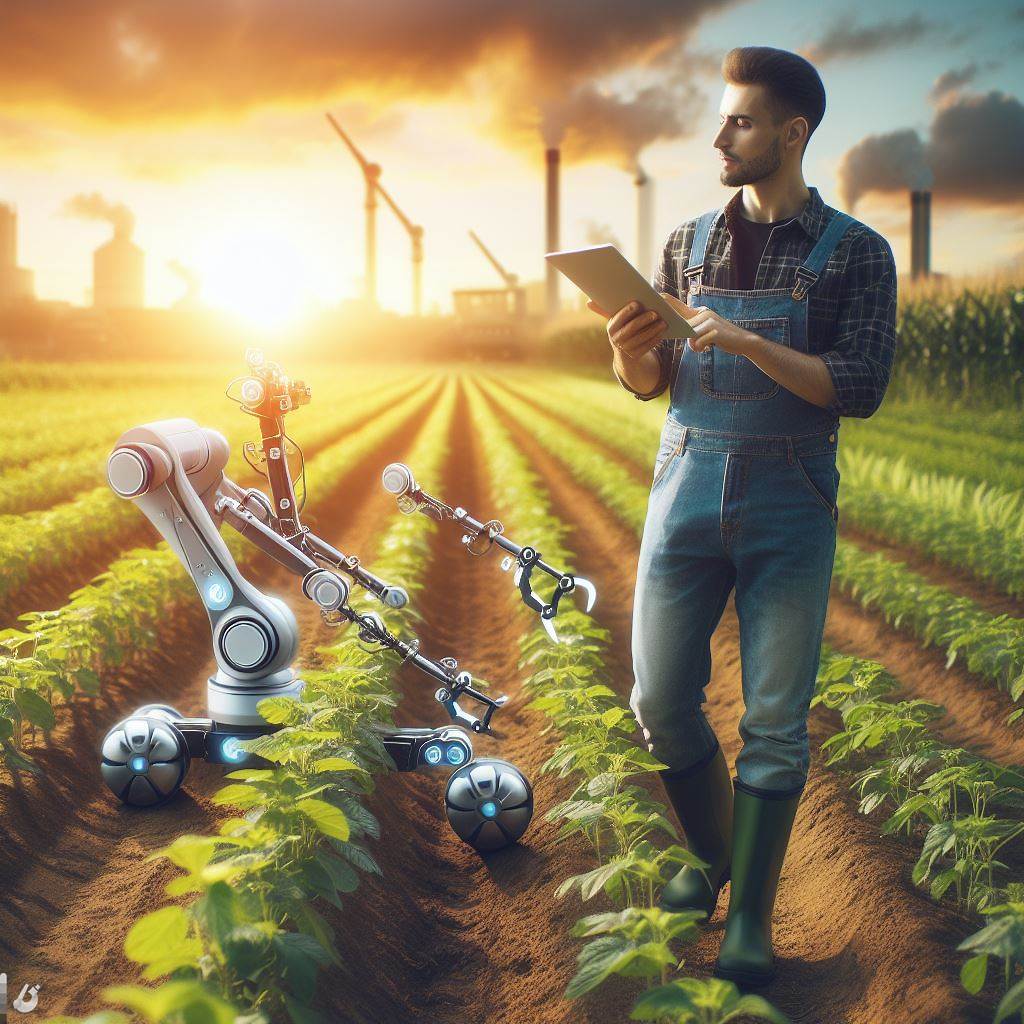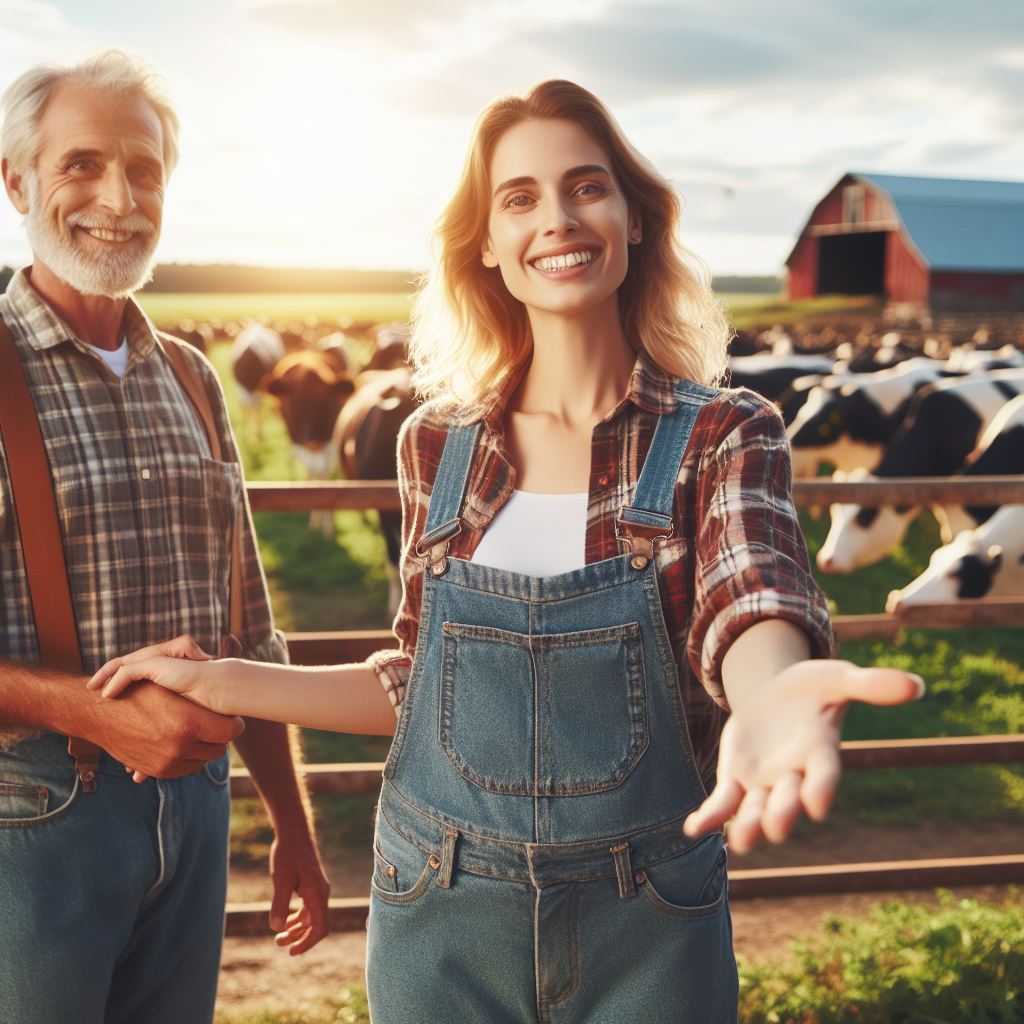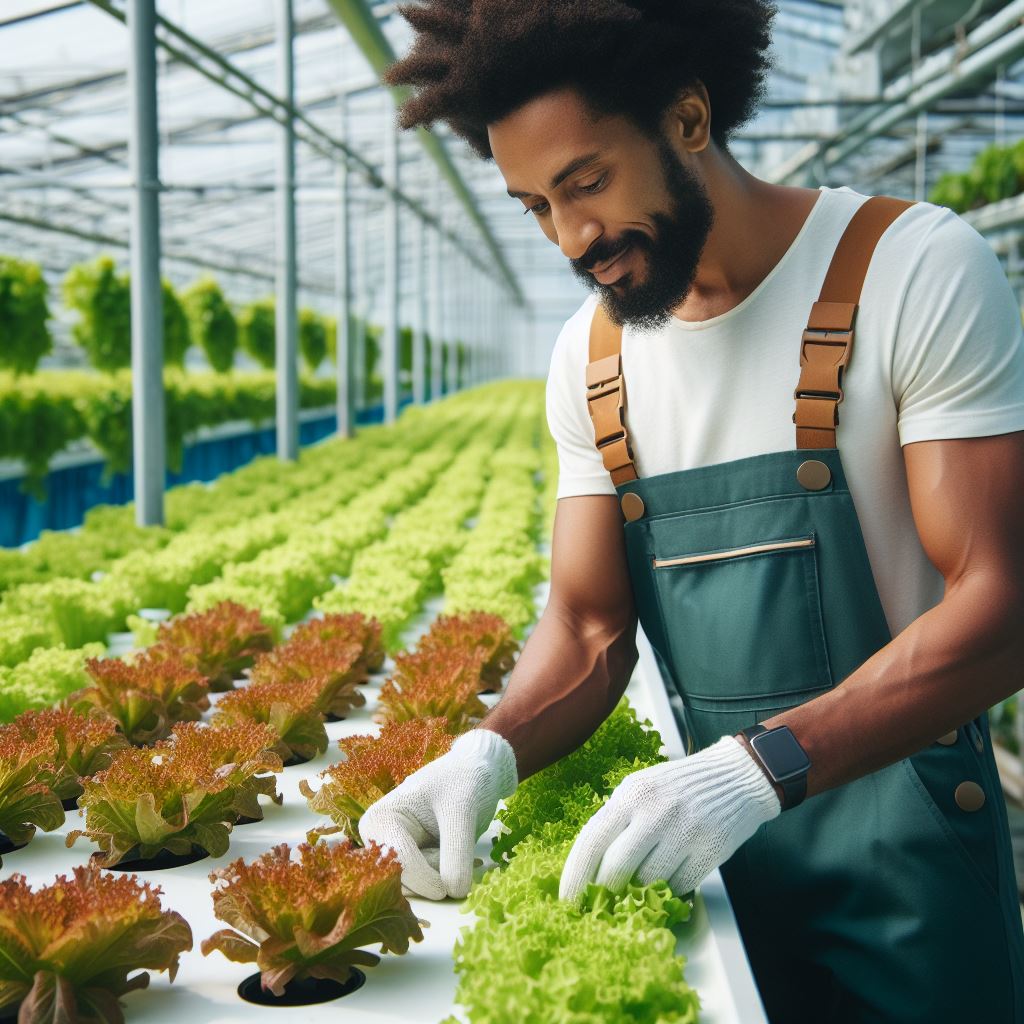Introduction
Robotics is revolutionizing the field of farming, paving the way for agri-tech advancements.
Agri-tech refers to the application of technology in agriculture, playing a crucial role in enhancing productivity, sustainability, and efficiency.
Agri-tech encompasses various disciplines, combining robotics, artificial intelligence, and Internet of Things (IoT) technology.
It enables farmers to automate tasks such as planting, harvesting, and monitoring crops.
This integration of robotics and farming is transforming agriculture on a global scale.
The importance of agri-tech cannot be understated.
With the world’s population expected to surpass 9 billion by 2050, there is an urgent need for sustainable and efficient food production.
Robotics in farming can address this challenge by optimizing crop yields and minimizing resource wastage.
Robots equipped with sensors and cameras can collect precise data on plant health, soil moisture, and nutrient levels.
This data is then used to inform farmers’ decisions, allowing them to provide targeted care to crops.
Additionally, autonomous machines can work day and night, increasing productivity and reducing labor costs.
The use of robotics also enhances sustainability in farming.
By leveraging precision technology, robots can apply fertilizers or pesticides only where needed, reducing chemical usage and environmental impact.
This approach improves soil health and water quality, promoting sustainable food production practices.
In fact, the integration of robotics in farming, also known as agri-tech, has immense potential in revolutionizing agriculture.
By embracing this technology, farmers can improve productivity, sustainability, and overall efficiency, ultimately ensuring food security for the growing global population.
The Current State of Farming
Farming has come a long way, but traditional methods still dominate the agriculture industry.
- Traditional farming methods involve manual labor and rely heavily on human intervention.
- Farmers face numerous challenges, including labor shortages, high costs, and low efficiency.
- The need to increase productivity to meet growing demands puts additional pressure on farmers.
- Traditional farming often requires a large workforce, which can be difficult to manage and retain.
- Due to the labor-intensive nature, traditional farming methods are time-consuming and inefficient.
- Furthermore, traditional farming practices can adversely impact the environment through excessive chemical use.
Despite these challenges, farmers have been striving to find innovative solutions to improve their operations.
Labor Challenges
- Farmers struggle to find sufficient skilled labor due to the migration of the rural population to urban areas.
- Seasonal labor demands make it difficult to meet the fluctuating needs of agricultural activities.
- Physical labor in farming can be demanding, which limits the number of individuals willing and able to work.
Efficiency Challenges
- Farmers often face difficulties in achieving optimal efficiency in planting, irrigation, and pest control.
- Manual monitoring and management of crops require significant time and effort.
- Uneven crop growth due to inconsistent manual practices affects overall productivity.
- Inefficient use of resources, such as water and fertilizers, adds to the economic burden on farmers.
Productivity Challenges
- Inefficient farming practices hinder the ability to meet the increasing demand for food.
- Farmers struggle to maximize yield and profitability while maintaining sustainability.
- Inconsistent crop quality and quantity impact market competitiveness and profitability.
- Climate change and unpredictable weather patterns further complicate productivity in farming.
The future of agriculture lies in the integration of robotics and advanced technologies.
Benefits of Robotics in Farming
- Labor Automation: Robots can perform repetitive tasks, reducing the dependence on human labor.
- Increased Efficiency: Automated systems can monitor and manage crops with precision, optimizing resource usage.
- Improved Productivity: Robots can work tirelessly, 24/7, ensuring consistent and high-quality crop production.
- Pest Control: Robotic applications can detect and remove pests without the need for harmful chemicals.
- Data-Driven Farming: Robotics enables data collection and analysis for better decision-making in farming practices.
Advancements in robotics have already made significant impacts in various agricultural processes.
Robotic systems can efficiently plant and harvest crops, reducing time and labor requirements.
Autonomous drones equipped with sensors and cameras can monitor crop health and identify areas that need attention.
Robotic weeding machines can precisely remove weeds, minimizing the use of herbicides.
Greenhouse automation systems regulate temperature, humidity, and irrigation, ensuring optimal plant growth.
As robotics in farming continues to evolve, costs of implementation are expected to decrease.
Transform Your Agribusiness
Unlock your farm's potential with expert advice tailored to your needs. Get actionable steps that drive real results.
Get StartedHowever, challenges such as technical limitations, high initial investments, and adaptability to different farming scenarios remain.
Nonetheless, the future of agri-tech looks promising, as robotics has the potential to revolutionize farming methods.
With increased automation and precision, farmers can overcome labor, efficiency, and productivity challenges.
It is crucial for stakeholders in the agriculture industry to embrace technological advancements and adapt to changing needs.
By leveraging robotics, farmers can usher in a new era of sustainable and efficient farming practices.
Robotics in agriculture: An overview
What robotics in farming entails
In today’s world, technology continues to advance and revolutionize various industries, including agriculture.
One particular aspect that has gained significant attention is the use of robotics in farming.
Robotics in agriculture refers to the integration of automated machines and robots in various farming tasks, aiming to enhance efficiency, reduce labor costs, and improve overall productivity.
The various types of robots used in agriculture
When it comes to robotics in agriculture, there are several types of robots that are commonly used.
Drones are one such example.
These unmanned aerial vehicles have become increasingly popular in recent years.
Drones equipped with advanced imaging sensors can provide valuable data and insights to farmers, such as crop health assessments, pest detection, and even irrigation management.
Another type of robot commonly used in agriculture is autonomous tractors.
These robots are capable of performing various tasks, including plowing, seeding, and harvesting, without direct human intervention.
They rely on advanced GPS technology and onboard sensors to navigate the fields accurately and efficiently.
Robotic harvesters have also gained traction in the industry.
These machines are designed to automate the process of picking fruits and vegetables.
With advanced computer vision and gripping mechanisms, they can identify ripe produce, detach it from the plant, and collect it accurately and delicately, mimicking the precision of human hands.
Robots can assist farmers in different tasks
These robots play a crucial role in assisting farmers in various tasks.
For instance, drones can provide farmers with real-time, high-resolution images of their fields.
This allows them to identify areas of concern, such as nutrient deficiencies or pest infestations, enabling them to take timely and targeted actions.
By doing so, farmers can optimize their use of resources, reduce wastage, and, ultimately, improve crop yields.
Autonomous tractors, on the other hand, can significantly reduce labor costs and time.
With their ability to operate 24/7, these robots can work tirelessly without the need for breaks.
They can perform tasks with precision, evenly distributing seeds and fertilizers, and ensuring consistent plant spacing, contributing to better crop quality and yield.
Robotic harvesters bring numerous benefits to farmers as well.
With their efficiency and accuracy, these machines can accelerate the harvesting process, reducing the time and labor required to collect crops.
Moreover, their delicate picking mechanisms minimize product damage, preserving the quality and value of the harvested produce.
In addition to their direct contributions to farming tasks, robotics in agriculture also holds great potential for data collection and analysis.
With the integration of advanced sensors and artificial intelligence, robots can gather extensive data on soil conditions, weather patterns, and crop growth.
This data can then be analyzed to gain valuable insights and make informed decisions regarding irrigation, pest control, and overall farm management.
In short, robotics in farming has emerged as a promising future for agriculture.
From drones capturing aerial images to autonomous tractors performing various tasks and robotic harvesters precisely picking fruits and vegetables, these robots play a vital role in improving efficiency, reducing labor costs, and ultimately enhancing overall productivity.
As technology continues to advance, the integration of robotics in agriculture will undoubtedly revolutionize the way farmers operate, leading to sustainable and more effective agri-tech practices.
Read: Emerging Markets in Agriculture
Advantages of Using Robotics in Farming
The integration of robotics in farming offers numerous advantages that contribute to the future of agri-tech.
Let’s explore these benefits in detail:
Increased Efficiency and Productivity
One of the key advantages of using robotics in farming is the significant increase in efficiency and productivity.
Robots can perform tasks at a much faster pace than humans, allowing farmers to accomplish more in a shorter amount of time.
For example, autonomous robots can autonomously plant seeds, water crops, and even harvest produce.
With robots taking care of repetitive and time-consuming tasks, farmers can focus on more critical aspects of their operations.
Reduction in Labor Costs
Another significant advantage of robotics in farming is the reduction in labor costs.
Robots can perform various tasks that traditionally require human labor, reducing the need for a large workforce.
By replacing manual labor with robots, farmers can save considerable amounts of money on wages, especially in regions where labor costs are high.
Additionally, robotics minimize the dependency on seasonal workers, providing more stable and consistent operations throughout the year.
Minimization of Human Error
Human error is an inherent risk in any agricultural operation.
However, the use of robotics can significantly minimize this risk.
Robots are programmed to perform tasks precisely and accurately, reducing the likelihood of mistakes.
For example, autonomous machines can navigate through fields, detecting and managing weeds without damaging crops.
By eliminating human error, the overall quality of farming operations increases, resulting in higher yields and better produce.
Improved Resource Management
Efficient resource management is crucial in agriculture to optimize costs and minimize waste.
Robotics play a vital role in improving resource management in farming.
Through sensor technologies and data analytics, robots can precisely monitor and adjust resource usage.
They can measure soil moisture, nutrient levels, and other environmental factors to deliver water and fertilizer precisely where needed, minimizing waste.
This precise resource application not only saves costs but also minimizes the environmental impact of farming.
In general, the advantages of using robotics in farming are numerous.
Robotics increase efficiency and productivity, reduce labor costs, minimize human error, and improve resource management.
As the world’s population continues to grow, the demand for food production will increase.
Embracing robotics in agriculture will enable farmers to meet this growing demand sustainably while maximizing their productivity and profitability.
Read: Maximizing Profit: Farm Product Marketing

Applications of Robotics in Farming
Robotics technology has started revolutionizing the agriculture sector by improving efficiency, reducing labor costs, and increasing productivity.
Here are some key applications of robotics in farming:
Precision Agriculture and Crop Monitoring
- Robots equipped with sensors and cameras can collect real-time data on soil conditions, moisture levels, and crop health.
- This data allows farmers to optimize irrigation, nutrient usage, and detect disease or pest infestations early on.
- Using this information, farmers can make data-driven decisions and reduce waste while maximizing yield.
Pest and Weed Control
- Robotic systems can identify and remove weeds without the need for chemical herbicides.
- Using artificial intelligence and computer vision, robots can distinguish between crops and weeds accurately.
- This method reduces chemical usage, saves costs, and minimizes environmental impact.
Harvesting and Post-Harvesting Tasks
- Robots can handle labor-intensive tasks such as picking fruits, vegetables, and sorting them based on size and quality.
- Automated harvesting systems help reduce production losses caused by manual errors and labor shortages.
- Robots can also process post-harvest activities like sorting, packing, and grading, ensuring consistent quality.
Livestock Management
- Robotic systems can assist in managing livestock, monitoring their health, and providing necessary care.
- Cows can be milked automatically, and their behavior and health data can be analyzed in real-time.
- Robots can also handle tasks like feeding, cleaning, and moving animals, reducing human labor and improving efficiency.
In a nutshell, the future of agriculture lies in the integration of robotics technology.
Precision agriculture and crop monitoring allow farmers to optimize resources and increase productivity.
Pest and weed control robots help reduce chemical usage and minimize environmental impact.
Automated harvesting systems ensure efficient and accurate collection of crops, while robots in livestock management streamline care processes and improve efficiency.
With robotics in farming, we can expect a more sustainable, productive, and technologically advanced agricultural industry.
Showcase Your Farming Business
Publish your professional farming services profile on our blog for a one-time fee of $200 and reach a dedicated audience of farmers and agribusiness owners.
Publish Your ProfileRead: Traditional Marketing: Key for Farm Success
Impacts on the agricultural industry
Robotics in farming has the potential to revolutionize the agricultural industry in numerous ways.
potential market growth and investment opportunities
Potential market growth and investment opportunities:
The adoption of robotics in farming is expected to drive market growth and create investment opportunities.
The role of robotics in sustainable farming practices
Role of robotics in sustainable farming practices:
Robotic technology can enhance sustainable farming practices by optimizing resource utilization and minimizing environmental impacts.
Address concerns about job displacement and the need for retraining
- Addressing concerns about job displacement: While robotics may automate certain tasks, it also creates jobs in new sectors such as robotics maintenance and programming.
- The need for retraining: As automation increases, there will be a need for farmers and agricultural workers to acquire new technical skills.
- Increased productivity and efficiency: Robots can work consistently and tirelessly, leading to increased productivity and efficiency in farming operations.
- Improved crop quality: Robotic systems can ensure precise planting, fertilizing, and harvesting, resulting in improved crop quality.
- Reduced labor costs: By replacing manual labor with robotics, farmers can significantly reduce labor costs and improve profitability.
- Optimized use of resources: Robotic systems can monitor and adjust resource usage, such as water and fertilizers, resulting in optimized resource utilization.
- Enhanced data collection and analysis: Robotic sensors and AI technologies can collect and analyze vast amounts of data to inform decision-making in farming.
- Improved farm safety: Robots can perform dangerous tasks, reducing the risk of injuries and accidents for farmers and workers.
- Integration with precision agriculture: Robotic systems can be integrated with precision agriculture techniques, leading to more accurate and targeted farming practices.
- Reduced environmental impact: Robotics can minimize the use of agrochemicals and optimize irrigation, leading to reduced environmental impact.
Robotics in farming can positively transform agriculture, addressing job displacement concerns through retraining and creating new job sectors.
Adopting robotic technology enhances sustainability, increases productivity, and improves crop quality.
It optimizes resource utilization, collects valuable data, and enhances farm safety.
Precision agriculture techniques contribute to overall efficiency and reduced environmental impact.
As the agricultural industry embraces robotic technology, investment opportunities and market growth are expected.
In summary, robotics in farming signifies the future of agri-tech, promising vast potential for innovation and advancement.
Read: Boost Sales: Digital Marketing in Agri World
Challenges and limitations
Cost and accessibility of robotic technology
The cost and accessibility of robotic technology can be a major challenge for farmers.
Integration with existing farming infrastructure
Integrating robots with existing farming infrastructure may require significant investment and modifications.
Designing robots suitable for different farm environments
Designing robots for diverse farm environments, terrains, and crops is challenging.
Robots must efficiently maneuver in various conditions, handling uneven terrain and unpredictable obstacles.
Specific robot designs may be needed for certain crops to prevent damage during tasks like harvesting or maintenance.
Developing adaptable robots for seasonal changes and diverse agricultural practices is crucial.
Robots must work effectively in both outdoor and indoor farming. Implementing robotic technology on large farms is complex due to size and diversity.
Training farmers to operate and maintain robots requires significant investment in education and support.
Ensuring access to technical support and spare parts for robotic systems is crucial for long-term viability.
Robotics in farming raises concerns about job displacement among agricultural workers, necessitating addressing ethical and social implications.
Maintaining data privacy and security when using robotics and AI-based systems in farming poses challenges.
Interoperability between different robotic systems and equipment is an issue, requiring standardization of interfaces and communication protocols.
Testing and validating robotic technologies for different farming scenarios require extensive research and development. Securing regulatory approvals and certifications for robotic systems can be time-consuming and costly.
Robots need constant updates to keep up with technology and changing farm requirements.
Ensuring longevity and durability of robotic systems is essential for a return on investment.
Addressing power supply limitations and providing efficient energy management solutions for robots is essential.
Basically, despite immense potential, challenges like cost, accessibility, integration with existing infrastructure, and ethical considerations need addressing for widespread adoption of robotics in farming.
Continued research and development efforts are crucial for unlocking the full benefits of agri-tech in the future.
Future prospects
Emerging technologies and research in agri-tech
- Artificial Intelligence (AI) advancements are leading to the development of more sophisticated robotics for farming.
- Drones equipped with advanced sensors and AI capabilities are being used for crop monitoring and pest control.
- Precision agriculture technologies, such as satellite imagery and GPS-enabled systems, are becoming more accurate and efficient.
- Vertical farming, utilizing indoor environments and LED lighting, is gaining popularity for its high productivity and small footprint.
- Genetic engineering and biotechnology are being explored to create crops with increased resistance to pests, diseases, and environmental stresses.
Predictions for the future of farming with robotics
- Robotic systems will become an integral part of farming operations, replacing manual labor and increasing productivity.
- Advanced AI algorithms will enable robots to make complex decisions, such as identifying and treating specific weeds or diseases.
- Swarm robotics, where multiple robots work together autonomously, will be employed for tasks like harvesting or pollination.
- Robotics will enable round-the-clock farming, reducing crop losses due to weather conditions or time constraints.
- Customizable robots will be developed to cater to the specific needs of different crops or farming practices.
Potential benefits for farmers and consumers alike
- Increased efficiency and precision in farming operations will lead to higher crop yields and reduced resource wastage.
- Robots can continuously monitor crops, identify problems early on, and apply targeted treatments, reducing the need for chemical inputs.
- Labor-intensive tasks can be automated, relieving farmers from physically demanding work and allowing them to focus on strategic decision-making.
- Robotics can improve food safety by minimizing human involvement in handling and processing, reducing the risk of contamination.
- Cost savings from reduced labor and increased productivity can potentially result in more affordable and sustainable agricultural practices.
In closing, the future of agri-tech with robotics looks promising.
Emerging technologies and ongoing research are pushing the boundaries of what is possible in farming.
With the integration of AI, drones, precision agriculture, and genetic engineering, farming will become more efficient, sustainable, and higher yielding.
Farmers will benefit from increased productivity, reduced labor, and improved decision-making, while consumers will enjoy safer and more affordable food.
The next few decades are likely to witness further advancements in robotics, revolutionizing the way we produce and consume food.
Conclusion
Robotics in farming represents a revolutionary leap forward, offering a host of potential benefits that can transform the agricultural landscape.
As we reflect on the trajectory of agri-tech, it’s crucial to recognize the immense possibilities that lie ahead and the responsibilities that come with integrating advanced technologies into traditional farming practices.
Summary of the Potential and Benefits
- Increased Efficiency: Robots can maneuver efficiently, reducing the time and labor required for various tasks.
- Precision Agriculture: Robots equipped with sensors and AI enable precise crop monitoring and targeted interventions.
- Cost Reduction: Automation can lead to reduced operational costs, making farming more economically viable.
Encouragement for Further Research and Development
- Innovations in Design: Continued research can lead to the creation of robots tailored for specific crops and terrains.
- Advanced Adaptability: Further development can enhance robots’ ability to adapt to seasonal changes and diverse agricultural practices.
- Improved Interoperability: Ongoing efforts in standardization can facilitate seamless integration of different robotic systems.
Emphasis on the Importance of Sustainable Farming Practices
- Environmental Impact: Robotics can contribute to sustainable agriculture by minimizing resource usage and reducing the environmental footprint.
- Balancing Technology: While embracing technology, it’s crucial to maintain a balance with sustainable farming practices.
- Ethical Considerations: As automation advances, addressing concerns about job displacement and ensuring ethical treatment of workers is paramount.
In navigating the future of agri-tech, fostering a harmonious coexistence between technology and sustainable farming practices is imperative.
It’s not just about embracing the latest innovations but doing so responsibly, considering the long-term impact on the environment, communities, and the overall well-being of the agricultural sector.
The road ahead involves collaboration among farmers, researchers, policymakers, and technology developers.
By working together, we can unlock the full potential of robotics in farming, ensuring a future where technology enhances productivity without compromising the integrity of our agricultural ecosystems.
In review, the era of robotics in farming beckons, promising increased efficiency, precision, and cost-effectiveness.
Let us embark on this journey with a commitment to ongoing research, development, and responsible adoption.
The future of agri-tech is bright, but its success lies in our ability to strike the right balance between cutting-edge technology and sustainable farming practices.
As we embrace the robotic revolution, let it be a testament to our commitment to a resilient, efficient, and environmentally conscious agricultural future.




